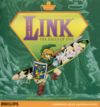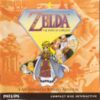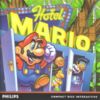Difference between revisions of "Nintendo Games on Philips CD-i"
(New page: In 1989, Nintendo has a deal signed with Sony to develop a CD-ROM add-on for the Super Nintendo. However, Nintendo broke the contract and signed on with Philips (the fallout with S...) |
|||
| (One intermediate revision by one other user not shown) | |||
| Line 1: | Line 1: | ||
| − | In 1989, [[Nintendo]] | + | In 1989, [[Nintendo]] had a deal signed with Sony to develop a CD-ROM add-on for the [[Super Nintendo]]. However, Nintendo broke the contract and signed on with Philips (the fallout with Sony leading to the creation of the Playstation) for the add-on. In the end, Nintendo canceled the idea of a add-on and proceeded to develop the [[Nintendo 64]]. However during the negotiations, Philips received limited rights to use Nintendo characters. This resulted in three [[Portal: Legend of Zelda|Legend of Zelda]] titles and one [[Portal: Mario Brothers|Mario]] title being made for their system, CD-i. |
| − | All four of these games were developed without the influence of [[Shigeru Miyamoto]] or any other Nintendo staff. Because of this these games are not considered canonical by either Nintendo or fans. | + | All four of these games were developed without the influence of [[Shigeru Miyamoto]] or any other Nintendo staff. Because of this these games are not considered canonical by either Nintendo or most fans. |
=Zelda Titles= | =Zelda Titles= | ||
| − | The first two Zelda games featured animated cut scenes by a Russian animation company. They are seen in the beginning and end and throughout the games whenever talking to non-playable characters. They both feature a side-scrolling view based off of [[Zelda II: The Adventure of Link]]. | + | The first two ''Zelda'' games featured animated cut scenes by a Russian animation company. They are seen in the beginning and end and throughout the games whenever talking to non-playable characters. They both feature a side-scrolling view based off of ''[[Zelda II: The Adventure of Link]]''. |
==Link: Faces of Evil== | ==Link: Faces of Evil== | ||
[[Image:Facesofevil.jpg|100px|right]] | [[Image:Facesofevil.jpg|100px|right]] | ||
| − | With [[Ganon]] long defeated, [[Link]] feels useless | + | With [[Ganon]] long defeated, [[Link]] feels useless having nothing left to do. The peace of Hyrule is suddenly broken when Gwonam arrives, alerting the king that the land of Koridai has been taken over by Ganon. With no time to waste and armed only with his sword, Link and Gwonam fly to Koridai to fight the Faces of Evil. |
| − | This is the only game of the Philips Zelda trilogy that featured Link as a playable character. | + | *This is the only game of the Philips Zelda trilogy that featured Link as a playable character. |
==Zelda: The Wand of Gamelon== | ==Zelda: The Wand of Gamelon== | ||
| Line 19: | Line 19: | ||
The King departs for the land of Gamelon after Ganon invades. He tells Link that if he does not return in a month, to come looking for him. A month passes and Link goes after the King and he too sends no word that he is safe. Eventually [[Zelda]] herself goes to the land of Gamelon to find Ganon and free her father and Link. | The King departs for the land of Gamelon after Ganon invades. He tells Link that if he does not return in a month, to come looking for him. A month passes and Link goes after the King and he too sends no word that he is safe. Eventually [[Zelda]] herself goes to the land of Gamelon to find Ganon and free her father and Link. | ||
| − | The game is notable for being the first Zelda game (though unofficial) where Zelda is the main playable character. | + | *The game is notable for being the first Zelda game (though unofficial) where Zelda is the main playable character. |
==Zelda's Adventure== | ==Zelda's Adventure== | ||
| Line 35: | Line 35: | ||
==Super Mario's Wacky Worlds== | ==Super Mario's Wacky Worlds== | ||
| − | The game was designed as a sequel to [[Super Mario World]] by NovaLogic for the CD-i. The game was canceled before it could be finished and Hotel Mario was instead developed. | + | The game was designed as a sequel to ''[[Super Mario World]]'' by NovaLogic for the CD-i. The game was canceled before it could be finished and Hotel Mario was instead developed. |
Latest revision as of 07:04, 22 May 2018
In 1989, Nintendo had a deal signed with Sony to develop a CD-ROM add-on for the Super Nintendo. However, Nintendo broke the contract and signed on with Philips (the fallout with Sony leading to the creation of the Playstation) for the add-on. In the end, Nintendo canceled the idea of a add-on and proceeded to develop the Nintendo 64. However during the negotiations, Philips received limited rights to use Nintendo characters. This resulted in three Legend of Zelda titles and one Mario title being made for their system, CD-i.
All four of these games were developed without the influence of Shigeru Miyamoto or any other Nintendo staff. Because of this these games are not considered canonical by either Nintendo or most fans.
Zelda Titles[edit]
The first two Zelda games featured animated cut scenes by a Russian animation company. They are seen in the beginning and end and throughout the games whenever talking to non-playable characters. They both feature a side-scrolling view based off of Zelda II: The Adventure of Link.
Link: Faces of Evil[edit]
With Ganon long defeated, Link feels useless having nothing left to do. The peace of Hyrule is suddenly broken when Gwonam arrives, alerting the king that the land of Koridai has been taken over by Ganon. With no time to waste and armed only with his sword, Link and Gwonam fly to Koridai to fight the Faces of Evil.
- This is the only game of the Philips Zelda trilogy that featured Link as a playable character.
Zelda: The Wand of Gamelon[edit]
The King departs for the land of Gamelon after Ganon invades. He tells Link that if he does not return in a month, to come looking for him. A month passes and Link goes after the King and he too sends no word that he is safe. Eventually Zelda herself goes to the land of Gamelon to find Ganon and free her father and Link.
- The game is notable for being the first Zelda game (though unofficial) where Zelda is the main playable character.
Zelda's Adventure[edit]
Released a year after the first two Zelda games, Zelda's Adventure uses an overhead view like the other Zelda titles and uses live-action sequences instead of animated pieces. In the game, Tolemac (Camelot backwards) is in the middle of a Age of Darkness after Ganon kidnapped Link and took over the country. Princess Zelda sets out to save him, but learns from the astronomer Gaspra that she must first collect seven celestial signs before she can defeat Ganon and bring back peace.
Mario Titles[edit]
Hotel Mario[edit]
Hotel Mario is a puzzle game rather than a platformer. Contrary to the three Zelda titles, Hotel Mario was more faithful to the source material and featured several familiar Mario characters and enemies, such as Bowser and the seven Koopalings. The game begins when Mario and Luigi are invited by Princess Peach for a picnic. When they arrive they find that Bowser has kidnapped the princess and challenges them to brave his variety of hotels to save her.
Super Mario's Wacky Worlds[edit]
The game was designed as a sequel to Super Mario World by NovaLogic for the CD-i. The game was canceled before it could be finished and Hotel Mario was instead developed.



